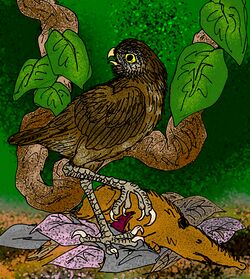Biology:Ornimegalonyx
| Giant Cuban owl Temporal range: Late Pleistocene
| |
|---|---|

| |
| Scientific classification | |
| Domain: | Eukaryota |
| Kingdom: | Animalia |
| Phylum: | Chordata |
| Class: | Aves |
| Order: | Strigiformes |
| Family: | Strigidae |
| Genus: | †Ornimegalonyx Arredondo, 1954 |
| Species | |
The giant Cuban owl or giant cursorial owl (Ornimegalonyx) is an extinct genus of giant owl that measured 1.1 metres (3 ft 7 in) in height. It is closely related to the many species of living owls of the genus Strix.[1] It was a flightless or nearly flightless bird and it is believed to be the largest owl that ever existed. It lived on the island of Cuba.
The first fossil specimen was mistakenly described as a bird in the family Phorusrhacidae, in part because the bones were so large. In 1961, Pierce Brodkorb reviewed the findings and identified them to have belonged to an owl. Remains have been abundant throughout the island, in cave deposits from the Late Pleistocene period (126,000 to 11,700 years ago) and at least three nearly complete skeletons have been found.
Taxonomy
In the past, three additional species of Ornimegalonyx besides O. oteroi were regarded as valid. All were described in 1982 and include:
- Ornimegalonyx minor Arredondo, 1982[2]
- Ornimegalonyx gigas Arredondo, 1982[2]
- Ornimegalonyx acevedoi Arredondo, 1982[2]
A 2020 study concluded that those species are all synonyms of O. oteroi, and describe a new valid species, Ornimegalonyx ewingi, from material formerly assigned to the prehistoric horned owl Bubo osvaldoi.[3]
"Ornimegalonyx arredondoi" is a nomen nudum; the name was proposed for this species before it was described but oteroi was eventually adopted by Oscar Arredondo (according to the rules of the ICZN, naming a species after oneself is not prohibited, but it is frowned upon as vain by the scientific community[citation needed]).
Description
Arredondo estimated the height of Ornimegalonyx to have been 1.1 m (3 ft 7 in) tall.[4][5] It had very long legs for its size, but was bulky overall and probably short-tailed. Its body mass in life is initially estimated to have been approximately 30 kg (66 lb),[6] but later studies suggest a mass of 9 to 13.5 kg (20 to 30 lb).[7][8][9][10] The modern owl that most resembles the Cuban giant owl in proportions is probably the dainty and quite small burrowing owl, the only surviving owl closely tied to the ground. This implies similar adaptations to the terrestrial lifestyle, but not a close phylogenetic relationship.[5]
The legs and feet of the Cuban giant owl appear to be very large and powerfully built. This supports the theory that they were strong runners, hence the alternate name, cursorial. The keel of the sternum was reduced and the owl may have been capable of short burst of flight. It is probable that, like a modern wild turkey, the owl only took flight when extremely pressed, more often choosing to run. The females of this owl species were larger than the males.[4][9]
Diet
The Cuban giant owl is believed to have preyed principally on large hutias, including Capromys, Geocapromys, and Macrocapromys (the latter being the size of a modern nutria or capybara) and the ground sloths Cubanocnus, Miocnus, Mesocnus, and Megalocnus, some of these sloths being roughly the size of a black bear.[4] It was probably an ambush predator that would pounce on unsuspecting prey with its crushing talons.
See also
- Tyto pollens
- Tyto gigantea
- Tyto robusta
- Grallistrix
- Chickcharney
- Late Quaternary prehistoric birds
- List of extinct birds
- List of fossil birds
- List of extinct animals
- Flightless birds
References
- ↑ Feduccia, Alan (1996) "The Origin and Evolution of Birds" Yale University Press
- ↑ Jump up to: 2.0 2.1 2.2 Arredondo, Oscar (1982). Los Strigiformes fósiles del pleistoceno cubano. Boletín de la Sociedad Venezolana de Ciencias Naturales 140, 33-55.
- ↑ Suárez, William (2020). "Remarks on extinct giant owls (Strigidae) from Cuba, with description of a new species of Ornimegalonyx Arredondo". Bulletin of the British Ornithologists' Club 140 (4): 387–392. doi:10.25226/bboc.v140i4.2020.a3.
- ↑ Jump up to: 4.0 4.1 4.2 Arredondo, Oscar (1976) translated Olson, Storrs L. The Great Predatory Birds of the Pleistocene of Cuba pp. 169-187 in "Smithsonian Contributions to Paleobiology number 27; Collected Papers in Avian Paleontology Honoring the 90th Birthday of Alexander Wetmore"
- ↑ Jump up to: 5.0 5.1 Arredondo, O. (1972). Especie nueva de lechuza gigante (Strigiformes: Tytonidae) del Pleistoceno cubano. Boletín de la Sociedad Venezolana de Ciencias Naturales 124/125: 129–140.
- ↑ Arredondo, O. 1970. Nueva especie de ave pleistocénica del orden Accipitriformes (Accipitridae) y nuevo género para las Antillas. Ciencias Biológicas, 4: 1–19.
- ↑ Egbert Giles Leigh, Annette Hladik, Claude Marcel Hladik, Alison Jolly. The biogeography of large islands, or how does the size of the ecological theater affect the evolutionary play. Revue d’Ecologie, Terre et Vie, Société nationale de protection de la nature, 2007, 62, pp.105-168. ffhal-00283373
- ↑ Kurochkin, E. & Mayo, N. A. (1973). Las lechuzas gigantes del Pleistoceno Superior de Cuba. Instituto de Geología, Academia de Ciencias de Cuba. Actas, Resúmenes, Comunicaciones y notas del V Consejo Científico 3: 56–60.
- ↑ Jump up to: 9.0 9.1 Alegre, Y. (2002). Análisis morfofuncional de la locomoción del búho gigante Ornimegalonyx oteroi (Aves: Strigidae) del Cuaternario de Cuba. Degree Thesis, Facultad de Biología, Universidad de La Habana.
- ↑ Feduccia, A. (1999). The Origin and Evolution of Birds. 2nd ed. Yale University Press, New Haven, Connecticut.
Wikidata ☰ Q2663732 entry
 |


